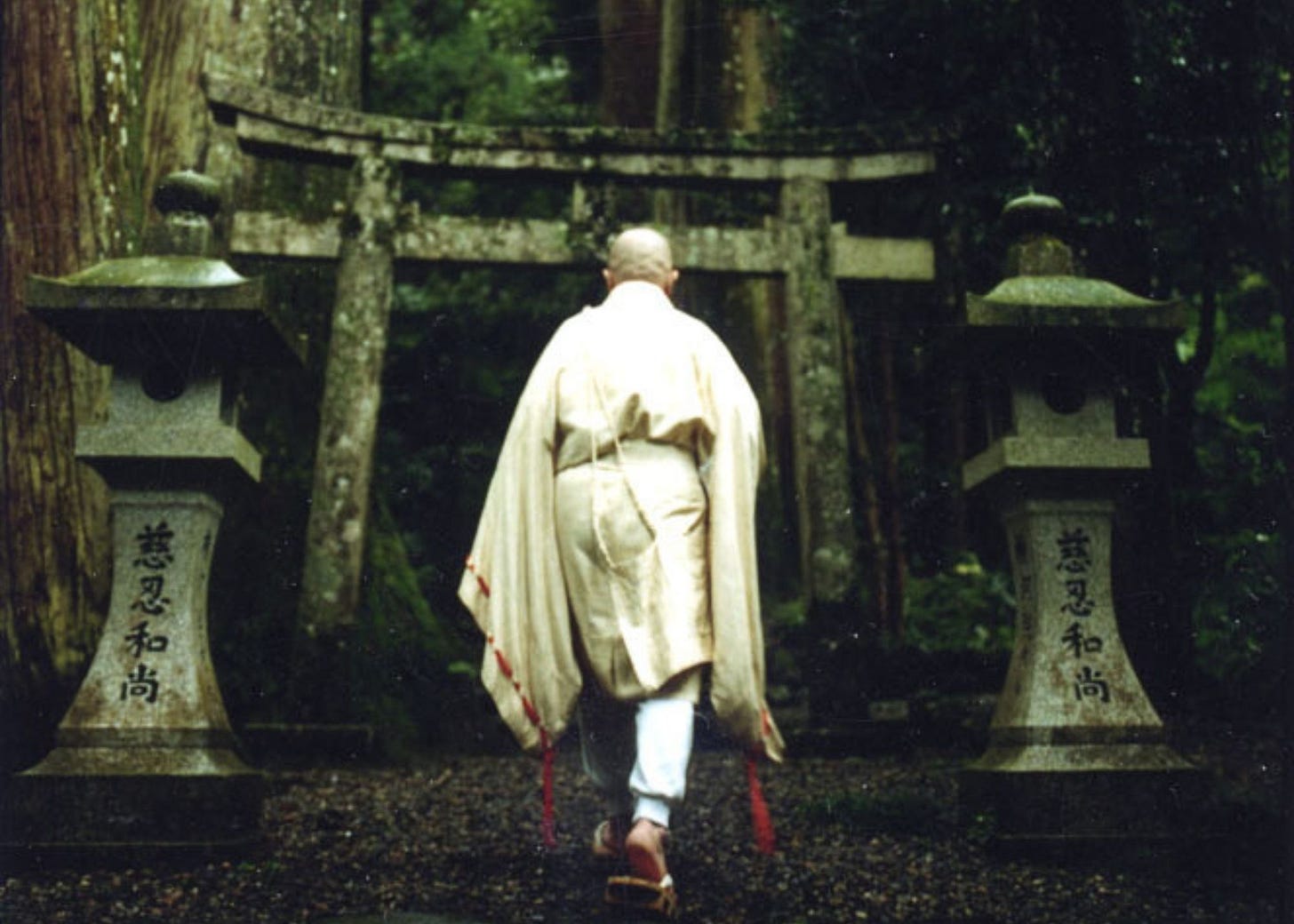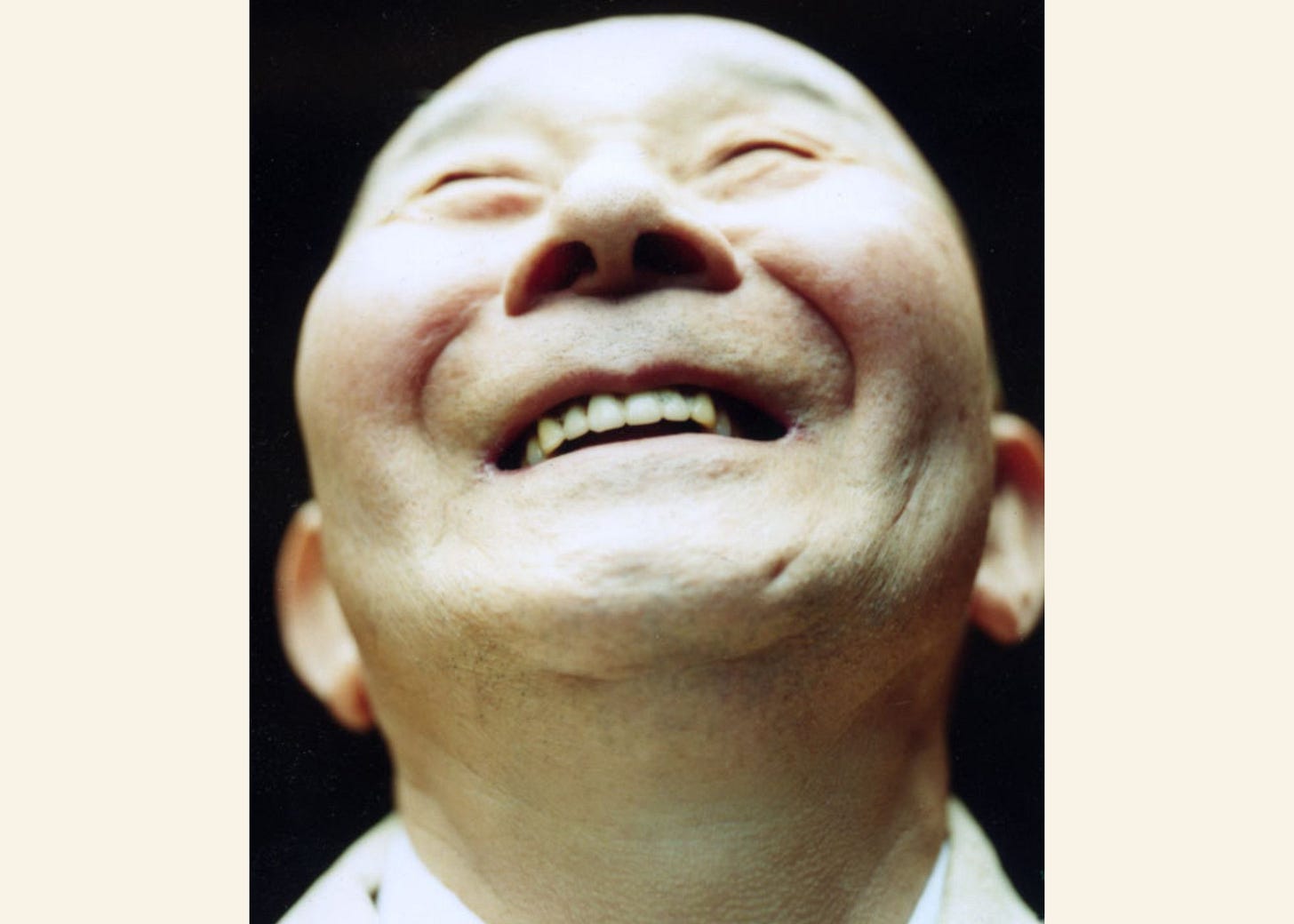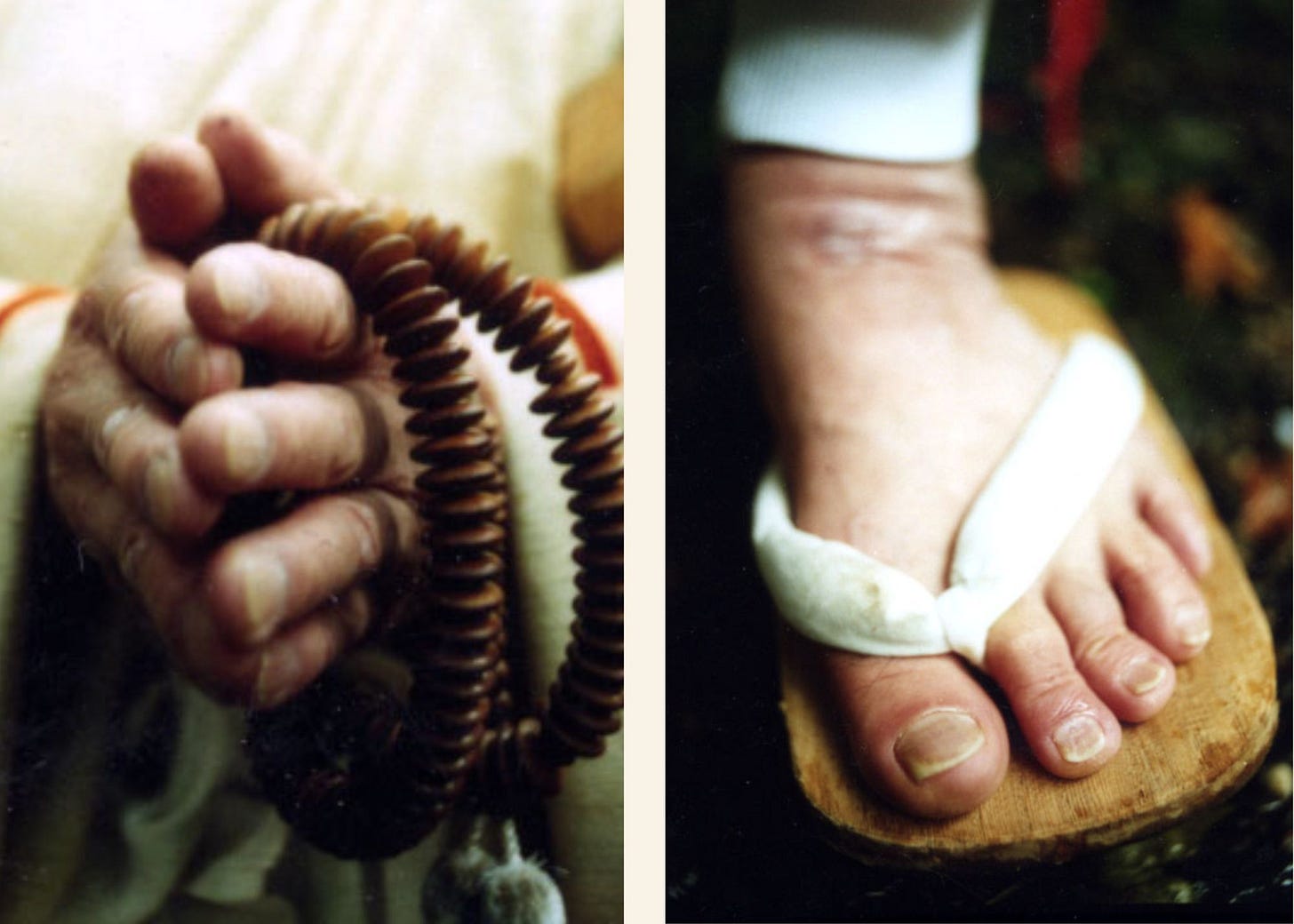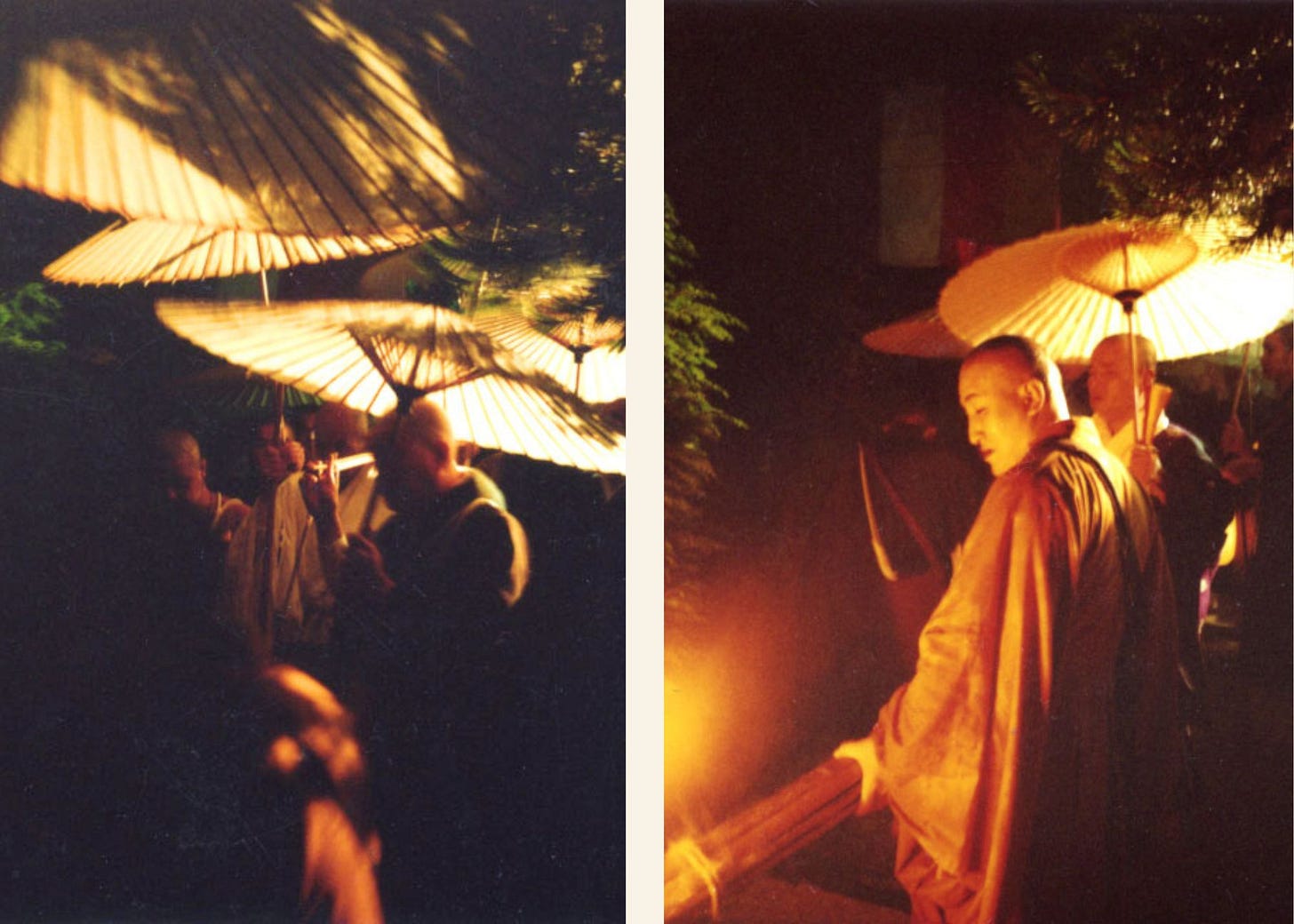The Metamorphosis Of A Marathon Monk
Yusai Sakai went from a life of failure to becoming a “Living Buddha” by completing the most grueling feat of endurance ever devised. Twice.
[Thank you to all the new subscribers! A lot of interest in cult murders and Nazis out there. Today, a vibe shift. A different era, country, tradition. And perhaps a story of hope to see us through the madness.
This piece is from the archive, from my first trip to Japan in 2002, a few months after 9/11. It was only ever published in the dummy for a start-up magazine called Lemonade that never quite started up. I travelled to Kyoto with this wonderful photographer who I’d credit if I could remember her name, but somehow it’s not in my notes.
We visited the Enryakuji Temple to join a community of monks who live out on the farthest extremes of human experience. And we had the immense honor of spending hours with their most fabled devotee, Yusai Sakai, a great man who passed in 2013.
As always, if this piece sparks any thoughts, please comment below, I’d love to hear from you.]
Two Thousand Days
In the lush foothills of Mt Hiei, overlooking the city of Kyoto, they call the monk Yusai Sakai a living God for the way he once ran—further and harder than anyone in Japan, perhaps anyone in our lifetime. Sakai ran to within a gasp of death, not just to visit the brink of mortality but to stay there a while. His austerities were so tortuous, it hurts to even recount them.
The last time was in 1988, when at the age of 61, he completed two marathons per day for 100 days in succession. According to the unsparing strictures of his practice, he would rise at midnight for a simple meal of vegetables, tofu and miso soup, his only daily sustenance. At no time was he allowed to stop for rest or refreshment, nor to remove the heavy, invariably rain-sodden monastic robes and long furled hat. The only footwear permitted, despite the jagged, slippery terrain, was a crude pair of straw slippers, no socks, and at all times he had to carry a burden of candles, food for strangers, and books containing directions to the innumerable places of worship he had to visit en route, the prayers he had to recite. On a good day, Sakai would return relatively intact about 18 hours later. On a bad day, he'd limp in gashed and bloody having been attacked by wild boar or bitten by vipers. His wounds often became infected. He received no medical help. Either way, by midnight, he'd be running again.
Fellow monks recall seeing the old man labor up and down the hard, wet mountain in his distinctive upright running style, his hat bobbing behind the trees and disappearing into the mist. They recall his stoic expression, a mask for the myriad agonies that tore through his body—the raging thirst, burning muscles and shredded feet, not to mention the knowledge that his only alternative to completing the course was death, either by exhaustion or suicide. That’s why Sakai also ran with a knife at his side, a rope known as the 'cord of death', white robes symbolizing death and a white ceremonial handkerchief used to veil the dead in funeral ceremonies. In his distinctive hat, shaped like a lotus blossom, he would carry a coin, in case he died, so that he could pay the ferryman to cross the mythic river between life and death. And he would always put on his sandals indoors before leaving, indicating that he was prepared to never return (the Japanese never wear shoes indoors). Death is ever present. The itinerary is graced with shrines to monks for whom the end came before the finish. Since 1885, only 47 monks have completed this pilgrimage, perhaps the most punishing ascetic feat ever devised.
The Sennichi Kaihogyo is the summit of achievement for monks of the Tendai Buddhist order, the fabled 'marathon monks', or 'running Buddhas' of the Enryakuji Temple on Mt Hiei. It lasts 1000 days, commonly distributed in 100-day chunks over a period of seven years, and in addition to traditional monastic chores, it includes no end of 'kaihogyo', literally "the practice of circling the mountains". Starting with 19 miles per day for 100 days at a stretch, then climbing to 200 days, the Sennichi Kaihogyu also includes a grueling 9-day fast known as Do-iri during which the monks are not only denied food, water and sleep, but must recite mantras and maintain correct posture at all times. Only then does the distance increase to 34 miles and then 52 miles, for a 100 consecutive daily double-marathons.
It is believed that to complete the 1000-day challenge makes one a "Saintly Master Of The Highest Practice", or “Living Buddha”. And of the few that survive today, Sakai, the 9th Living Buddha of the modern age is the greatest. When he hung up his straw slippers in 1988, he had completed his 2000th day of training. In other words, he had finished the Sennichi Kaihogyo twice, one of only three monks in history to have done so.
“The first time I didn't feel satisfied, I could have done a lot of things better," he said. So as he approached his sixties, he set about completing his second 1000-day challenge, without sustaining a injury. And he did it in six, rather than seven years.
Piece of cake.
The Living Buddha
Panting up the hill to his temple abode, I felt woefully unworthy of an audience with Sakai. Never mind the agonies he has transcended, he’s also a national hero in Japan, the subject of several books and documentaries who explained Buddhism to Pope John Paul II.
The photographer, interpreter and I were greeted at the gates by his younger brother, a cheerful scruffy man in turned-up jeans and battered sneakers who, despite the hushed serenity of the scene, was in a Lewis Carroll hurry. Paying no heed to the babbling brook below or the scintillas of sun bursting through the canopy above, he whisked us off on a whistle-stop tour of the temple: courtyard, idol, prayer bell, fountain, fish pond, garden, big gold Buddha, wow d’you see that Buddha, and finally, the exhausted drop-off at Sakai's door where we removed our shoes.
Suddenly, all was still. Creeping nervously through Sakai's quiet carpeted home, we discovered him sitting at a low cluttered table, under the fierce gaze of a figure of Fudo, the God to whom the temple is dedicated. (Fudo is said to have appeared to a mountain monk here over 1000 years ago.) At his feet were a profusion of gifts from his many global visitors, and on the walls were several shots of his meeting with the Pope in the early 90s.
"Come in, come in!" he beckoned, springing to his feet, a short, beaming man in full cream cotton right down to the dinky foot gloves that individually wrapped his toes. He hadn’t been expecting us, despite numerous email confirmations—“I don't pay much attention to that thing," he said, tossing his diary to one side. "I believe that life is now!” He poured us green tea and smiled so warmly his thin eyes disappeared into a concertina of calming wrinkles. My trepidation dissolved. "Now what is it you would like to know?" he asked. And we spoke that day for three hours, sitting on the floor around his table. Myself, Sakai and an interpreter.
Sakai has none of the severity or obscurity I expected—he neither dispenses wisdom from on high nor shelters behind koan riddles. Instead, he laughs and tells simple stories about "once when I was going around the mountain.” The way he describes it is fitting—he says guru-guru-guru-guru-guru very quickly and stirs the air with his hands. I had brought a list of questions, but wasn’t sure if I could ask them, what with the formal politeness of the scene—the accumulation of Japanese manners, a spectacular monastery, and a Living Buddha. But Sakai was attentive, curious, patient. He answered everything I asked.
A Man Adrift
He told me his story, a remarkable tale of a man adrift, wracked by guilt and grief who, in his forties, undergoes a tremendous metamorphosis through spiritual labor. It’s all the more inspiring because Sakai was never "likely to succeed,” rather he was considered a shiftless dullard who would never amount to anything.
The eldest of ten children, he grew up in poverty. His father was a rice merchant who went bankrupt and was later drafted in the war against China. In an effort to support the family, Sakai found work at a military hospital laboratory but the pay was so poor that he often went hungry himself, living off the feed for the lab animals. He couldn’t find better work because he kept failing at school, so he enlisted in the army, because the recruitment drive offered automatic graduation if you completed military training. Given his morbid bent, Sakai picked the kamikaze pilot program. He was stationed at a naval base in Kagoshima that was routinely bombed by Americans, and he witnessed the death of many comrades. But he never got to fly his kamikaze mission because WWII ended before his training was complete. So he still didn’t graduate. And the survivors guilt clawed at him. “Why have so many fine men perished,” he said, “while a no-account like me remains alive?"
He found filing work at a university library and, seduced by his new setting, resolved to graduate from school once more. This time he was so confident that, before retaking his exams, he boasted far and wide that he'd already passed and would definitely be a university student next term. When he failed again—“I was third from the bottom in all subjects!”—he was so ashamed, that rather than admit it, he faked it.
“When I took the train to go to university, I’d get off at the stop beforehand and just wander around all day. That was the start of my wandering lifestyle,” he said. He drifted from job to job, from clerk to noodle vendor to black marketeer, propelled either by necessity or any number of fleeting whims. "Sometimes I'd find work for a month, sometimes two years, but I'd wander and work, wander and work. I had no purpose. That's how it was until I was 40.” At which point, his aimlessness led to the transformative tragedy of his life—his wife committed suicide.
"My poor wife," recalled Sakai. "Her mother told her to leave me because I was a good-for-nothing, but my wife’s position was very difficult. It is very difficult for her to leave her husband, but she also had a responsibility to her mother and father. So she was caught in a dilemma. The only thing she could do was to leave us both, so she removed herself entirely. She saw herself as the cause of this problem between mother and husband. It was very sad.”
Although he didn’t dwell on the loss with us, at the time, her death left him devastated, alone and approaching 40. He was so anguished that his ex-mother-in-law, of all people, and asked him to stay close for the mourning period. She was a part of this Enryaku-ji temple, the home of the marathon monks, and she enlisted his help in traveling there—it was his first ever visit. When they returned to Osaka, however, she kept on at him to make something of his life, and he found himself turning again toward the mountain.
“She always scolded me about my aimless life and told me to pull myself together and become a man. I would tell her, ‘please leave me alone!’ But the only way to escape her scolding was to come here. So one night, I left Osaka at 7pm, and walked all through the night and arrived here at Enryakuji at about 4 or 5 the following afternoon. She called the temple and asked them to look after me because I was a bit unsettled, a bit off. I was standing right there in front of the monk when he got the call. He said, ‘what do you mean? He’s not mad at all!’”
Taking pity on Sakai the monks broke their rules of not permitting anyone over 35 to become a disciple. They had him purify himself by standing beneath a freezing waterfall and then they taught him some rituals that he could begin his practice with. “I had to perform a prayer ceremony three times a day that involved rising from kneeling to standing 108 times,” he said. “After two days I asked them to ‘send me back, I’ve had enough’. But after a while, I got used to it. And every time that I rose, I could feel my devotion grow.”
It was 1965.
The Nine Day Fast
Sakai invited us to stay that night at the temple guest house. Simple quarters but pristine. We had come at a good time, apparently. A monk named Fujinami, 42, was performing kaihogyu, the first in 10 years to attempt it, and we could witness if we wished. He was undergoing the excruciating throes of Do-iri, the nine day fast which meant that every day, at around 2am, he would emerge from his seclusion and perform the water ceremony—walking 200 yards downhill to the well, and returning with two pails. It sounds simple but come Day 6, he was already withered by dehydration and wrestling powerful hallucinations. This fast is absolute—he doesn’t just skip food, but also water and sleep.
The temple was abuzz with anticipation. A coach load of followers arrived in the afternoon, and a TV crew, and the coffee lounge beside the gift shop was thick with their cigarette smoke. It's odd, all this smoking here in the crisp mountain air, around such dedicated runners. But the Japanese are also dedicated smokers and anyway, the marathon monks are not traditional athletes in the pursuit of health and perfection. Rather they are looking to transcend their bodies, the husk of the soul. One veteran of Sennichi Kaihogyo is even a smoker himself.
Sat among the smokers was Sakai, in golden robes this time, bashfully accepting the reverence of those around him. "I don't like to wear all this gold," he whispered. "But if I don't these people will be disappointed." Sakai had come to preface the water ceremony later that night with a lecture about his own experiences.
"Your nails die during Do-iri and you develop deep furrows in your hands, between your fingers," he explained, as members of the audience moved around the hall taking pictures. "You also realize how sweet water tastes. When you are permitted to rinse your mouth out, many men become hysterical and delirious, they want to seize the cup, they speak to it." Sakai chuckled. "You get a full glass of water but to make sure you do not drink any, there is a test. When you spit it back the glass is supposed to overflow, because during the fast, your mouth accumulates a lot of residue, mostly blood." The first time Sakai underwent Do-iri, he spat out a thick brown fluid, as is typical. The second time, however, his spittle was clear.
Do-iri is regarded as the most treacherous stage of Sennichi Kaihogyu, more dangerous even than the endless marathons. But incredibly, Sakai regards his first Do-iri as only his second closest brush with death. His nearest miss took place in 1971, barely six years into his monkhood, when he revived the "ceaseless nembutsu", a practice that involves chanting the name of Buddha ("Hail to Amida Buddha") incessantly for 90 days at a temple called Jogyo-do, while walking around a blood-red candle-lit hall and stopping for only two hours of sleep per day. It’s deemed so dangerous that it had been banned since the Meiji era when the last monk who attempted it collapsed, his legs swelling to twice their normal size. His parting words were “please do not let anyone do this anymore.” So in wades Sakai a century later; he always had a taste for the ultimate showdown.
“I began to fall,” he said. “I’m sure if someone else saw me it looked like I just fell like a stone, but what I experienced was more like a glider coming down. Like its taking an age, this fall, like slow motion. When I closed my eyes I saw this golden glow in the distance, and all these dancing specks of light, and I remember coming down from what seemed like an immense height and gliding into the specks of light. I’m sure that if I’d just followed the feeling, and if I hadn't opened my eyes when I hit the floor, I would have passed over into death."
When Sakai spoke of suffering like this, I felt pulled in different directions. Awed that a man could accomplish such things, and further convinced by the ancient traditions which teach that mortification can bring transcendence, after all Sakai does seem to have emerged cleansed from his ordeals. But the path is so stark as to be unreachable. It’s a realm apart.
The Water Ceremony
Fujinami's water ceremony took place on a fittingly drenched night, at one of the temples tucked deep into the mountain, a good hour’s hike away. Sakai himself couldn't be there, but he'd arranged for a young Zen master called Takyebashi (literally "Bamboo Forest") to accompany us instead. Bamboo was an unlikely companion – a 31 year old meditation teacher with a secret penchant for hard rock. As we trudged down the mountain, squelching and crunching on wet pebbles, Bamboo would call out the names of bands he liked. “Marilyn Manson-o! Ozzy Osbourne-o!” In the distance we could make out the natter of old women, huddled under temple-blue umbrellas but charging up the mountain nonetheless—the same women who were chuffing ciggies in the lounge hours before. "Nine Inch Nails-o!" announced a delighted Bamboo.
At the temple, lit loud with lanterns, one hundred pilgrims and a TV crew jostled for a glimpse of the heroic Fujinami. When he appeared, weary on his feet, he was swiftly surrounded by stern monks bearing lanterns and umbrellas, and as the sombre procession marched down the hill, the crowd began to pray for the monk's soul, a leaden dirge that Sakai later informed me, had no literal translation since it was not composed of any recognisable words—rather it was a crude Japanese mimickry of the sound of a Sanskrit chant. "It is the sound that matters," said Sakai, "the sound has the power."
It was a visceral, elemental night. There was fire and water and a full moon on a mountain top. A small crowd of strangers had gathered to witness the near-death of another and the air was humming with ancient incantations that few understood. I had an odd feeling of collective solitude. The rain was relentless—even as I cursed my puddle shoes, I thought about rain, the bane of a marathon monk’s life. When he runs, it triples the burden of his robes, ruins his sandals and makes him slip and fall. And when he fasts, every drop mocks his fatal thirst. Everywhere you looked tonight was rain and the lush forest life it provides—you could hear it, feel it, smell it in the air—but only Fujinami, the wilfully dehydrated monk at the heart of it all was discovering its Buddha nature.
After 20 minutes, Fujinami returned, buckling under the weight, but otherwise focussed, impenetrable. As the temple doors closed behind him, and he returned to his punishing deprivation, we tramped back up the mountain, brimming with mortality.
“I Die Every Night”
The next morning we sat together for the last time, Sakai and I. Green tea, cross legged on the floor, that warm smile. It was just a final send-off, but I didn’t want it to end, so I asked some more questions, there were still a few left.
“What did you think about when you were running 84km per day for 100 days?” I ask.
“I remembered Tokyo,” he said. “When I was supposed to be at university, I would roam around all day instead, guru-guru-guru-guru. Stopping here and there, at the shops, the baseball park, the station. And I kept all the landmarks in my mind, going form one to the other. Little did I know that this was a rehearsal for what I did 20 years later—Buddha had obviously planned this for me! If you think about 84km per day, it’s very intimidating. But I did the same thing—I broke up my journey into stops, always thinking about the this statue around the corner or this temple, like that. That’s how you reach your destination. You must live your life step by step. Everyone has their own journey.”
“You came so close to death, so often. Why do you think you survived each time?”
“Because I did many bad things in my previous life, Buddha’s not going to let me off so easily. He will make sure I atone. I’ve been tapping on his door for a long time now, but no, he always sends me back for more!”
“And when the time comes, how would you like to die?”
“Oh I die every night!” he told me cheerfully. “And each morning I am born again. I have one life today and one tomorrow. This feeling grew within me each day after I circled the mountains.”
The interpreter tapped his wrist. It was time. So we stood and bowed and bowed again, thanking Sakai profusely. And he put a hand on my shoulder and kept it there as he turned to the interpreter for a final thought.
“Don’t put me a pedestal,” he said. “Everyone has to walk like me through life. If you take me away from the mountains, I’m just like anybody else.”
Sakai Yusai died on September 23rd at the Imuro Fudodo Chojuin Temple.
Further Reading:
Todd Tsuho Sattersten of Dharma Rain on The Marathon Monks
Marathon Monks of Mount Hiei, by John Stevens (Echo Point Books & Media, 1988).







You find the most curious deep dives into the ways lives are lived. For Yusai Sakai to have made the monastic leap at age 40 seems especially dramatic because the punishing regimen of rules was imposed in a man who was allowed in against the rules. And he carried a knife, a coin and a white cloth in preparation for his death.
I wonder sometimes about your fascination and involvement with the music business. To find a guide/postulant (is that what he was?) who loved Ozzy!! Is that stardust speaking.
More, please.
Wow! What a fascinating read with wonderful moments of levity, Sanj. It’s so hard to fathom how the monks survive those punishing races and fasting and running in slippers! They must all have plantar fasciitis. I love Yusai Sakai’s story. He’s a marvel. Thanks for sharing.